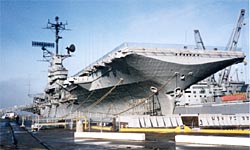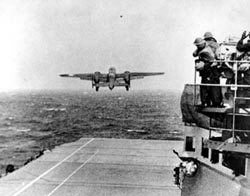
Located in Alameda, California, the USS Hornet(CV-12) was part of a wartime buildup of U.S. carrier forces in a war that demonstrated the vital role of naval aviation. As early as 1910, the U.S. Navy recognized the potential value that flight would have in naval operations. Although naval aviation was utilized during World War I, aircraft assigned to warships generally provided only reconnaissance support for the fleet. The possibility of using airplanes as a naval strike weapon did not begin until the 1920s when aircraft capable of performing heavy bombardment against land or sea targets were built. Naval vessels capable of carrying several squadrons of such aircraft were developed concurrently. Thus the first eight carriers constructed by the U.S. Navy varied in size, speed, protection and aircraft complement in order to provide the greatest number of carriers capable of launching the greatest number of air strikes, yet still comply with treaty-imposed tonnage restrictions. Essex(CV-9), the ninth U.S. carrier authorized, was a product of these earlier designs. A total of 26 Esssex-class carriers were ordered by the U.S. Navy between February 1940 and June 1943 and 24 were completed. This was the largest class of carriers ever built by the United States and over half, including USS Hornet (CV-12), served as part of the Pacific Fleet during World War II.
World War II and the carrier campaigns of the Pacific firmly established the role of aviation within naval operations and the aircraft carrier replaced the battleship as the Navy's primary strike weapon. Serving as mobile air bases, carriers could maneuver aircraft around the open waters and scattered island chains of the Pacific. By employing a combination of scouting, fighter or bomber aircraft to control the enemy's air power, groups of carriers, screened by surface ships, could open the way for island invasions, cover and support amphibious operations, and help to hold the conquered areas. Thus carriers became an integral compound of nearly every campaign throughout the Pacific War. With aircraft that extended the fleet's firepower beyond the range of large caliber battleship guns, the carrier's status was elevated from reconnaissance platform to that of major surface combatant.

Launched just 10 months after its predecessor, the USS Hornet (CV-8), was lost in battle, the newHornet had a distinguished World War II career that included the invasion of Saipan and the Battle of the Philippine Sea, the amphibious landing on Palau, the Philippines, Iwo Jima and Okinawa and strikes against the Japanese home islands. The USS Hornetand its air groups were credited with shooting down 688 planes, destroying another 742 aircraft on the ground, sinking a carrier, cruiser, 42 cargo ships and 10 destroyers and assisting in the sinking of the Japanese battleship Yamato. The Hornet received seven battle stars and the Presidential Unit citation during World War II. The USS Hornet was reactivated for the Korean conflict and its last combat deployment was as an antisubmarine warfare carrier in the Vietnam conflict.
The USS Hornet's exceptional career was capped with the recovery of the Apollo 11 and Apollo 12 astronauts at the end of these missions. Navy divers aided the Apollo 11 crew, astronauts Neil A. Armstrong, Edwin E. Aldrin, Jr. and Michael Collins, back to the Hornetafter the capsule hit the water. The Apollo crew, wearing containment suits because of the possibility of introducing alien bacteria, stepped from the helicopter, waved and entered quarantine. President Richard M. Nixon welcomed the astronauts back to earth aboard the carrier . "Hornet plus three" then steamed for home. The Navy announced the impending retirement of the USS Hornet on January 15, 1970, and the carrier was decommissioned on June 30.
Visit the National Park Service Travel American Aviation to learn more about Aviation related Historic Sites.
Last updated: August 22, 2017
